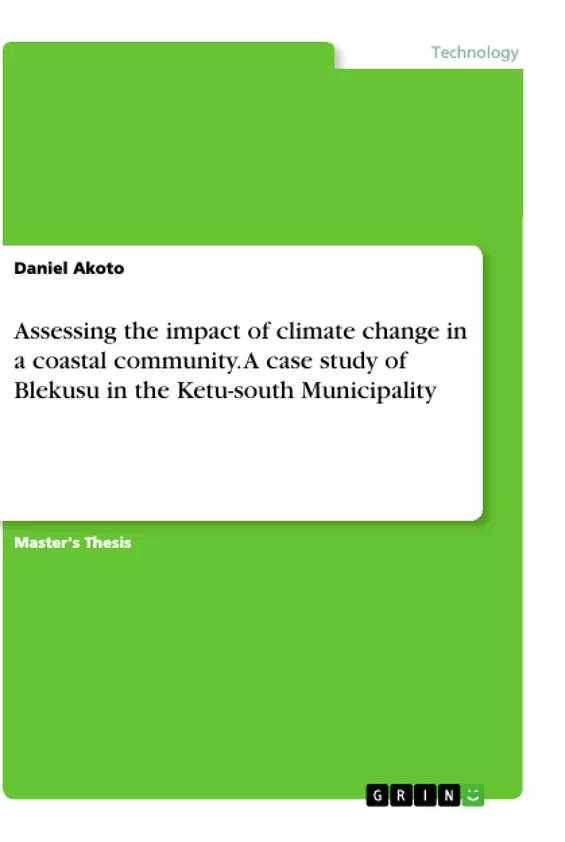Climate change and its consequences have more or less become an expected occurrence and an inevitable result of the world’s physical, biotic and chemical processes. From global increase in temperatures, continuous increase in sea level, loss of arctic sea ice, and changes in type, distribution and coverage of vegetation, climate change has become one of the worrying occurrences in the world. The impacts of climate change on Blekusu are not different from other coastal communities as the community is also a coastal community. The study was concerned with assessing the impact of climate change on Blekusu, a coastal community in the Ketu-South municipality. The study revealed that destruction of infrastructure as a result of the rising sea volume is one impact of climate change that is worrying the people of Blekusu. The study also revealed that construction of a sea defense wall is one way by which the destruction caused by the rising sea volume can be prevented. In this regard, the study therefore recommended that the government of Ghana must ensure that existing institutions, agencies and functionaries in charge of educating the public with respect to climate change and its effects in the country are adequately equipped to be able to discharge their duties effectively.
Inhaltsverzeichnis (Table of Contents)
- CHAPTER ONE
- INTRODUCTION
- BACKROUND TO THE STUDY
- PROBLEM STATEMENT
- OBJECTIVES OF THE STUDY
- SPECIFIC OBJECTIVES
- RESEARCH QUESTIONS
- SIGNIFICANCE OF THE STUDY
- SCOPE OF THE STUDY
- ORGANISATION OF THE STUDY
- CHAPTER TWO
- LITERATURE REVIEW
- Introduction
- THE CONCEPT OF CLIMATE CHANGE
- EFFECTS OF CLIMATE CHANGE ON LIVELIHOODS
- CAUSES OF CLIMATE CHANGE
- MITIGATING THE EFFECTS OF CLIMATE CHANGE
- THE CLIMATE CHANGE SITUATION IN GHANA
- THEORETICAL FRAMEWORK
- The Theory of Change
- The Anthropocene Theory
- CHAPTER THREE
- RESEARCH METHODOLOGY
- OVERVIEW
- RESEARCH DESIGN
- STUDY AREA
- STUDY POPULATION
- SAMPLING SIZE AND TECHNIQUE
- SOURCES OF DATA
- DATA COLLECTION METHOD
- DATA ANALYSIS
- LIMITATIONS OF THE RESEARCH
- ETHICAL CONSIDERATIONS
- CHAPTER FOUR
- ANALYSIS AND DISCUSSION OF FINDINGS
- INTRODUCTION
- GENERAL INFORMATION OF THE RESPONDENTS
- STATUS OF CLIMATE CHANGE IN BLEKUSU
- Effects of Climate Change on the residents of Blekusu
- Mitigating the Effects of Climate change on the residents of Blekusu
- Assessing the efforts of the government of Ghana in mitigating the impact of climate change on the residents of Blekusu
Zielsetzung und Themenschwerpunkte (Objectives and Key Themes)
This thesis aims to assess the impact of climate change on the coastal community of Blekusu in the Ketu-south Municipality of Ghana. The study explores the specific effects of climate change on the livelihoods of residents, investigates the community's efforts to mitigate these effects, and examines the role of the Ghanaian government in supporting climate change mitigation initiatives within Blekusu.
- Climate Change Impacts in Coastal Communities
- Livelihoods and Climate Vulnerability
- Climate Change Mitigation Strategies
- Community-Based Adaptation to Climate Change
- Government Policies and Climate Action
Zusammenfassung der Kapitel (Chapter Summaries)
Chapter One provides the background to the study, focusing on the specific problem of climate change in Blekusu and outlining the research objectives, questions, and significance. Chapter Two delves into the literature review, defining climate change, exploring its effects on livelihoods, examining the causes and mitigation strategies, and discussing the situation in Ghana. Chapter Three describes the research methodology employed, including the research design, study area, population, data collection methods, and ethical considerations.
Schlüsselwörter (Keywords)
Climate change, coastal community, Blekusu, Ketu-south Municipality, Ghana, livelihoods, mitigation, adaptation, government policies, environmental science, policy and management.
- Arbeit zitieren
- Daniel Akoto (Autor:in), 2020, Assessing the impact of climate change in a coastal community. A case study of Blekusu in the Ketu-south Municipality, München, GRIN Verlag, https://www.grin.com/document/958818



